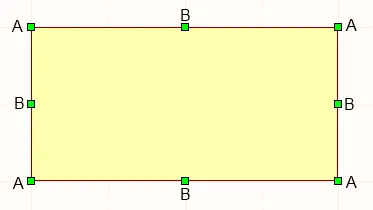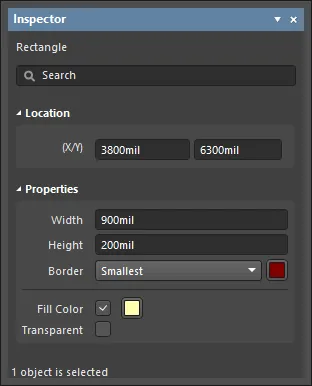Rectangles are available for placement in the following ways.
From the schematic editor:
- Choose Home | Graphical Elements | Rectangle from the main menus.

- Right-click in the design space then choose Place » Drawing Tools » Rectangle from the context menu.
From the schematic library editor:
- Choose Home | Circuit & Graphical Elements | Rectangle from the main menus.

- Right-click in the design space then choose Place » Rectangle from the context menu.
After launching the command, the cursor will change to a cross-hair and you will enter rectangle placement mode. Placement is made by performing the following sequence of actions:
- Click or press Enter to anchor the first corner of the rectangle.
- Move the cursor to adjust the size of the rectangle then click or press Enter to complete placement.
- Continue placing further rectangles or right-click or press Esc to exit placement mode.
Additional actions that can be performed during placement while the rectangle is still floating on the cursor and before its first corner is anchored are:
- Press the Tab key to pause the placement and access the Rectangle mode of the Inspector panel from where its properties can be changed on the fly. Click the design space pause button overlay (
 ) to resume placement.
) to resume placement.
- Press the Alt key to constrain the direction of movement to the horizontal or vertical axis depending on the initial direction of movement.
- Press the Spacebar to rotate the rectangle counterclockwise or Shift+Spacebar for clockwise rotation. Rotation is in increments of 90°.
Graphical Editing
This method of editing allows you to select a placed rectangle object directly in the design space and change its size, shape or location graphically.
When a rectangle object is selected, the following editing handles are available:

A selected Rectangle
- Click and drag A to resize the rectangle in the vertical and horizontal directions simultaneously.
- Click and drag B to resize the rectangle in the vertical and horizontal directions separately.
- Click anywhere on the rectangle away from editing handles then drag to reposition it. While dragging, the rectangle can be rotated (Spacebar/Shift+Spacebar) or mirrored (X or Y keys to mirror along the X-axis or Y-axis).
To clear the selection of (or de-select) the object, use the Esc key.
Non-Graphical Editing
This method of editing uses the Inspector panel mode to modify the properties of a rectangle object.

During placement, the Rectangle mode of the Inspector panel can be accessed by pressing the Tab key. Once the rectangle is placed, all options appear.
After placement, the Rectangle mode of the Inspector panel can be accessed in one of the following ways:
- If the Inspector panel is already open, select the rectangle object.
- With the rectangle selected, choose View | Schematic | Inspector from the main ribbons.
Editing Multiple objects
The Inspector panel supports multiple object editing, where the property settings that are identical in all currently selected objects may be modified. When multiples of the same object type are selected manually, an Inspector panel field entry that is not shown as an asterisk (*) may be edited for all selected objects.